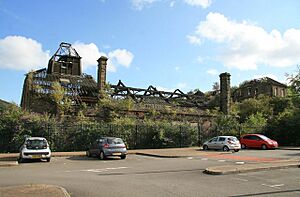Hafod Copperworks facts for kids
The Hafod-Morfa Copperworks is a very old industrial site in Hafod, Swansea, in Wales. It sits right next to the River Tawe. This site was once a huge copper factory. It was first built by a company called Vivian & Sons. Many of its buildings are now protected as Grade II listed buildings because they are so important to history. The whole area covers about 12 acres (4.9 ha)s.
Contents
History of the Copperworks
How the Copperworks Started
The Hafod works began in 1810. It was founded by a man named John Vivian from Cornwall. During the 1800s, this copperworks became the biggest in the world! More than 1,000 people worked there. Another copper factory, the Morfa works, started nearby in 1835. It was owned by Williams, Foster & Co. Later, in 1924, these two big sites joined together under one company, Yorkshire Imperial Metals.
Swansea's Copper Story
Swansea was super important for the global copper industry. By 1823, about 10,000 of Swansea's 15,000 residents relied on the copper industry for their living. This shows how big and vital it was! By 1883, there were 124 factories in the Lower Swansea Valley. Twelve of these were copper works.
Why Copper Production Changed
Over time, the natural copper resources in South Wales started to run out. It became cheaper to make copper in other parts of the world. Because of this, the copper industry in Swansea slowly declined. In 1971, a big project called the Lower Swansea Valley Project began. Its goal was to clean up and transform this industrial area. This led to the closure of the rolling mills at the copperworks in 1980. The old rolling mills were later turned into the Landore Collection Centre. This center is now part of Swansea Museum.
Bringing the Site Back to Life
Plans for Renewal
In 2010, local leaders started talking about new plans for the Hafod-Morfa Copperworks site. They wanted to save the old, protected buildings. They also wanted to give these historic places new uses. The plans from 2010 included building a new hotel, a restaurant, and new homes on the site.
Working with Swansea University
In 2011, the local council chose Swansea University to help develop the site. The university looked into creating new academic facilities there. Public grants of £540,000 were given to help save and renew the site. The first stage of work began in October 2013. This involved clearing away overgrown plants and doing important repair work to preserve the buildings.
New Developments and Future Hopes
In 2019, exciting plans were approved for the Morfa side of the site. A distillery and visitors' center for the Penderyn brand were built there. Construction began at the end of 2019, and the center opened in 2022. This project received a big boost from a £3.75 million grant from the National Lottery Heritage Fund.
Other parts of the copperworks have also been worked on. The Musgrave Engine House and Vivian Engine House were made safe. There is hope for even more restoration work on them. The Morfa Bascule Bridge, which used to serve the site, is also planned to be fixed and returned to working condition.


